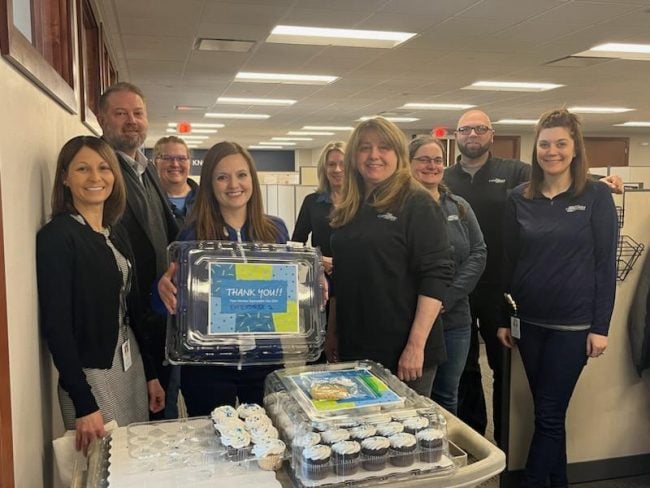Credit unions were likely not around during WilliamShakespeare's time but that hasn't stopped Member One FederalCredit Union from using his poems and plays to reach out to itsemployees.
|The $599 million credit union in Roanoke, Va., developed “Usingthe Humanities to Give Business Training a Soul” program, whichincludes a diverse offering of courses related to sales, softskills, economics and leadership that are business related with ahumanities-based theme.
|By bringing in other areas of the humanities, such as economics,history, and even philosophy and political science, participantsfind a rewarding environment that helps them to better understandthe financial environment and climate in which they work, saidScott Crawford, professional development director for Member One.
|
Employees at Member One Federal Credit Union visited theMuseum of Frontier Culture to get a taste of frontier life and takelessons about teamwork back to the credit union.
|“We explore contemporary issues, from local to global events,from an historical, economic, and socio-political context, thuswidening participants' views and understandings about issuesdirectly coming to bear on our credit union,” Crawford said.
|Eight credit unions were recent winners of the CUNA Human Resources and Training and Development Council's 2013Excellence Awards for implementing projects that have advancedemployee engagement, health and wellness programs, online trainingand strategic leadership.
|Member One's program, which involves music, dance, fine arts,poetry, literature and the works of Francesco Petrarch and WilliamShakespeare, took home one of the awards for employee engagement.
|“We recognized that all training simply had to be engaging andfun,” Crawford said. “We wanted to make sure that training classeswould provide an environment that sparked discussion and that wouldtake people somewhat out of their comfort zones.”
|Crawford and his team also wanted to create a learningenvironment that would encourage innovation and creativity.
|“Research related to the creative process clearly indicates thatassociating seemingly unrelated disciplines with each other leadsto innovative insights, so we wanted to expose participants todiverse content areas,” he said.
|Employees at Member One embarked went on an interesting fieldtrip to the American Shakespeare Center in Staunton, Va., in orderto explore Shakespeare from a perspective related to business.
|“A follow-up activity I designed involved the group breakinginto groups of three and identifying one Shakespeare character froma play and then analyzing the character using the DISC assessment,”Crawford explained.
|Created in the 1920s, Crawford said the DISC assessmentidentifies an individual as having one, or possibly two, dominantpersonality types. Based on the type, the person communicates acertain way and prefers people to communicate with him or her in acertain manner.
|“They then had to discuss how that character communicated andwould want people to communicate with him or her,” Crawford said.“They then had to identify a business or leadership theme foundwithin the play and associate it with our credit union.”
|Crawford said that the cost for this imaginative program isrelatively non-existent beyond salaries. Member One's humanresources department consists of three employees who focus on theseminars and academies while one employee conducts one-on-onetraining sessions that focus on soft skills such as communication,etiquette, being able to resolve conflict and learning how to beempathetic. The supplies to conduct the program are minimal,costing in the low $100s annually, he stated.
|“Much of what we do involves simply copying images and excerptsto examine or simply displaying images or excerpts throughPowerPoint,” Crawford said. “Again, the primary expense isemploying the people to conduct the training sessions; and yes, thecost is justified based on improved member engagement and overallproduct penetration.”
| Town & Country FCU's Employee Experience Teamvolunteered their time to help execute various employee-centeredactivities and events that created camaraderie and helped boostproductivity.
Town & Country FCU's Employee Experience Teamvolunteered their time to help execute various employee-centeredactivities and events that created camaraderie and helped boostproductivity.
Playwrights from the 14th century don't make an appearance inthe employee engagement program designed by the $234 million Town& Country Federal Credit Union in South Portland, Maine.However, the end result of employees having fun on and off the jobhas translated into improved production at the credit union. The program was alsohonored with one of the CUNA HR and Training and DevelopmentCouncil's 2013 Excellence Awards.
|Town & Country's Employee Experience Team, led by HR and agroup of employees who volunteered their time to help executevarious employee-centered activities and events that werereflective of the needs and desires of the staff, combined healthand wellness, sports and parties.
|“People spend more time at work than they do at home so wewanted to make sure the experience is a positive one,” said NicoleSears, chief people officer at Town & Country. “After weimplemented this program we found we had a higher production rateand people wanting to come into work.”
|Sears said the program cost is minimal and worth every extradollar. Planning exercise events, potlucks, zip line adventures andhayrides are ways that management can see what hidden talents theiremployees might have that may not show up during regular workhours.
|
To give it more authenticity, Member One FCU's ChiefFinancial Officer Alan Wade dressed as the Duke of Orange during aBattle of Waterloo exercise.
|“Our programs are 100% volunteer and sometimes we are surprisedat who takes charge,” said David Libby, president/CEO of Town &Country. “Often, being in charge of one of our teams can open doorsto new positions at the credit union.”
|Sears said that with this type of staff experience the employeesoften become friends at all levels in the credit union.“If the workenvironment is a pleasant one then we have stronger employees,” heexplained. “It becomes more than just a job.”
|Crawford said in tracking success in these types of programs,thereturn on investment of training is almost impossible to measure.Instead, the focus needs to be placed on the return on engagement,he noted.
|“Circumstantial evidence clearly suggests that Member One'straining program (is) having a positive effect, allowing forincreased profit, sales penetration and morale.”
Complete your profile to continue reading and get FREE access to CUTimes.com, part of your ALM digital membership.
Your access to unlimited CUTimes.com content isn’t changing.
Once you are an ALM digital member, you’ll receive:
- Critical CUTimes.com information including comprehensive product and service provider listings via the Marketplace Directory, CU Careers, resources from industry leaders, webcasts, and breaking news, analysis and more with our informative Newsletters.
- Exclusive discounts on ALM and CU Times events.
- Access to other award-winning ALM websites including Law.com and GlobeSt.com.
Already have an account? Sign In
© 2024 ALM Global, LLC, All Rights Reserved. Request academic re-use from www.copyright.com. All other uses, submit a request to [email protected]. For more information visit Asset & Logo Licensing.









